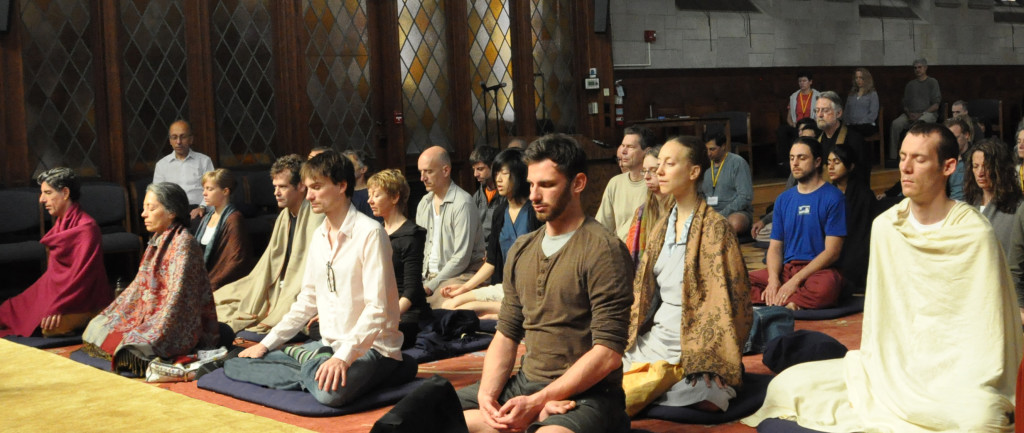
In my own experience with meditation, I’ve often wondered about the difference between reading a thoughtful analysis or set of instructions, listening to an inspiring teacher, and sitting on the cushion to practice. These varied activities represent different ways of integrating information into our minds and bodies—in short, different ways of learning.
Is one mode more effective than another? In the domain of contemplative science, this question becomes important as meditation interventions are being developed in a host of applied settings. As people learn about meditation conceptually, is that enough to change habits and behavior, or is practice required?
I’ve spoken informally to a few experienced teachers about their intuitions on this question. Some have a sense that learning in a didactic way, through study and discussion, is important to “set the stage” for experiential learning that takes place on the cushion. Perhaps through study, you’re building the cognitive scaffolding to help facilitate insights that may emerge through direct experience. At the same time, many of us are also familiar with shifts in understanding that come from listening to a lecture or reading a book.
Is there a way we can begin to tease out these effects experimentally? Recently, research from the Mind & Life community has addressed this question by examining the effects of experiential meditation practice versus didactic learning and discussion.
Study 1
In a study published in PLOS One, MLI Fellow Amishi Jha at the University of Miami evaluated the effectiveness of different styles of mindfulness training on attention-related outcomes. The participants were soldiers undergoing several months of intensive predeployment training. In periods of high stress and demand such as this, attentional capacities often degrade.
The study delivered short-form mindfulness training (8 hours delivered over 8 weeks) to these participants in the hopes of helping them maintain their attentional capacity in the midst of this high stress environment. (See our previous blog post for more on mindfulness in the military.) Importantly, the training was delivered in two ways. One group was more experientially focused, with the teacher prioritizing instruction about and engagement in mindfulness exercises (practice group). The second group was more didactically focused. These participants had the same teacher, but she prioritized instruction about the basic principles of neuroplasticity, stress, resilience, and self-regulation of the autonomic nervous system (discussion group). Both classes received the same manual on mindfulness, and had the same time requirements for mindfulness practice outside of class. Thus, the main difference was the material the teacher presented, and the amount of time spent practicing mindfulness together in class. There were two additional comparison groups that received no mindfulness training: another predeployment military group, and a civilian group (control groups).
Participants were tested before and after the 8 weeks of training using a computerized attention task. This test is quite demanding, requiring sustained attention and responding to a series of changing numbers for 15–20 minutes. Its easy for someone to lose focus under these conditions, and even more so when stressed. Researchers measure attention by looking at accuracy and speed of responses.
Over the 8 weeks of predeployment activities, performance on this test got worse in the military participants who did not receive any mindfulness training. These results are expected, due to the high levels of stress that military personnel experience during this time. By comparison, civilians living their normal daily lives did not show any degradation of attention over the same 8 weeks.
So what about the mindfulness groups? Interestingly, people in the discussion group—who learned through lecture and discussion, with relatively little mindfulness practice—showed attention deficits at the end of 8 weeks, just like the military group that received no training. However, those in the practice group—who emphasized in-class practice of mindfulness exercises—did not show any decline in attention, despite the same stressful predeployment experience as the other military participants. Researchers concluded that engaging in meditation practice may have bolstered attentional performance in the face of an intense environment, protecting these participants from the normal degradation that occurred in the other military groups.
This study did have limitations due to the difficulties of research in military cohorts. Specifically, randomization cannot be done on an individual basis; instead, platoon members must remain together for the trainings, which means effects of particular group dynamics cannot be ruled out. Limitations notwithstanding, these results suggest that actually practicing mindfulness meditation is more effective at buffering attention than learning about the topic conceptually.
Study 2
The second study that speaks to the question of “modes of learning” used a similar experimental approach, but examined the effect of lovingkindness meditation on social and intergroup relations. Conducted at Yale University by Varela Grantee Yoona Kang and published in the Journal of Experimental Psychology: General, the main outcome of this study was a test of implicit bias against two stigmatized groups: Black people and homeless people. The question was whether engaging in lovingkindness practice—a goal of which is to cultivate feelings of warmth and acceptance towards self and others—could reduce subconsciously held biases against these groups.
The study compared people who had been randomly assigned to one of three groups: participants practicing lovingkindness meditation in a 6-week class (practice group), those attending a 6-week class on lovingkindness led by the same teacher but who only engaged in discussion without practice (discussion group), and a group who had signed up but were not yet attending a class (waitlist control group).
Before and after the 6 weeks of classes, participants took a computerized test designed to tap “implicit associations.” By pairing sets of stimuli (e.g., positive or negative words paired with faces of people from different racial or social groups) and measuring reaction time, researchers are able to evaluate social biases that may be operating below the level of conscious awareness.
At the end of 6 weeks, the study found that implicit bias against both Black people and homeless people was reduced compared to baseline levels, but only for those participants who had been practicing lovingkindness. Those in the discussion group and on the waitlist did not change in terms of their implicit bias. Kang and her colleagues concluded that “lovingkindness meditation can improve automatically activated, implicit attitudes toward stigmatized social groups.” As this study only tested participants at the end of 6 weeks, future studies will need to determine the longevity of this effect.
So again, we have evidence that its the practice of meditation that’s effecting the change—this time in an important form of social cognition. Didactic and discussion-based methods don’t seem to have the same impact as engaging in the mind-body exercises of contemplation when it comes to altering deeply held mental habits.
Strong Designs
These studies stand out not only because of their findings indicating the importance of actual practice, but also because of their strong experimental designs.
In both cases, the discussion group served as an “active control” group. This means that they were exposed to many of the same potentially beneficial experiences as the practice group, except for the meditation itself (e.g., regular social interaction, the same teacher and conceptual material, time commitment away from one’s regular routine). Accounting for these additional variables is essential in contemplative research, as studies have found clinical improvements in various domains based on these elements alone. So it’s important to test a comparison group that is exposed to these other aspects of a meditation intervention, but without the contemplative practice.
Active control groups have become the gold standard for contemplative science, and I’m pleased to see the field beginning to use these kinds of carefully controlled designs to parse out the effects of different forms of learning. Employing these controls, this research strongly supports the idea that engaging in meditation practice is more effective—at least in terms of bolstering attention and changing social bias—than reading and discussing related concepts.
Learn By Doing
In many ways, these results are not surprising, and they agree with the intuition of the teachers I’ve spoken with. There seems to be something special about direct experience in terms of its impact on learning. As Aristotle wrote, “For the things we have to learn before we can do them, we learn by doing them.”
For example, imagine reading several books about oranges, how they look, smell, feel and taste, and discussing this with others. You’ll certainly gain some knowledge. But this kind of understanding pales in comparison to the immediate experience of holding, smelling, seeing, and eating an orange. In a way, this direct perception is simpler and faster than all the reading or talking one could do. The same comparison could be made for learning a new skill, like riding a bike.
Viewed from an evolutionary perspective, the human brain was exposed to experiential learning for millennia before language-based or written modes of learning evolved. Likewise, during an individual’s development, learning through experience begins in the womb, while the cognitive structures needed for didactic learning only develop years later. Thus, it makes sense that our brains are particularly sensitive and responsive to direct experience. It’s the most basic form of learning.
We know that during sensory perception (e.g., tasting an orange), motor learning (e.g., riding a bike), as well as the kind of mental training that occurs during meditation (e.g., building your attentional capacity, or changing your conceptualization of others), neuronal circuits are being re-shaped. Perhaps through these kinds of direct experience, the changes are more effective or long-lasting than with other ways of taking in information.
The question of what’s happening in the brain during these various modes of learning remains open for future research. But for now, we can take a simple lesson from the results of these studies — regardless of whether practice makes perfect, it may be the best way to make a change.


